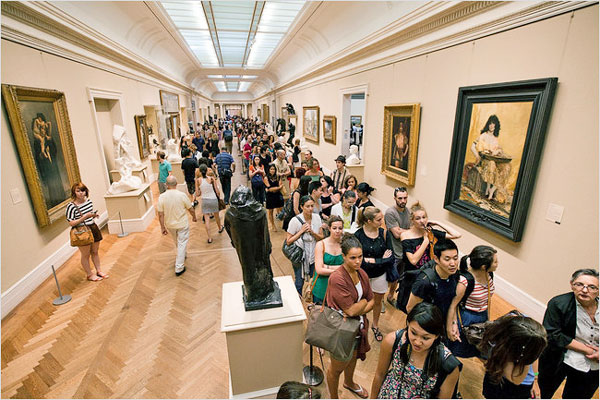At the met, McQueen's final showstopper
Updated: 2011-08-02 15:14
(The New York Times)
|
|||||||||||
 |
|
Guests have waited in line for hours to see the retrospective of the designer's work.[Photo/The New York Times] |
Word of mouth about the show, its fantastic theatricality and special effects that include a three-dimensional hologram of Kate Moss (as well as about the clothes, which include frightening concoctions made of feathers, razor clam shells, medical slides printed to look as if they were bloodied, resin vulture skulls and simulated human hair) has exposed Mr. McQueen's work to the kind of audience the designer had always dreamed about.
Ms. Verkade said he often complained that, season after season, he was showing his clothes to the same 700 or so editors and buyers. In 2009, when he was one of the first designers to stream a runway show live online so everyone could watch at the same time, the hosting Web site went down under the strain of consumer demand.
So it would be incorrect to suggest that Mr. McQueen was underappreciated in his lifetime: people clamored to see his shows, though his extreme behavior could sometimes aggravate the editors who followed him closely. Anna Wintour wrote in an editor's letter in Vogue that he had once flown over from London to be photographed by Irving Penn and then refused to leave his hotel room.
Because he was shy, Mr. McQueen seemed to be able to express himself most openly through his designs, but sometimes they were difficult to see clearly when the dresses passed by so quickly on a runway. Now in a museum, clothes that suggest romanticism, battles between darkness and light, between love and sadness, or even life and death, take on new meaning.
"He did imbue so much of his work with this sense of self," said Andrew Bolton, the curator of the exhibition. "I never realized it until I looked at all of his clothes, but he was such a brave person that he was able to use fashion to discuss and reveal his interior self."
In a sense, the popularity of the exhibition reflects not only the broadening cultural interest in fashion, but also a very specific interest in Mr. McQueen's work by young people, including a generation that is defined by its embrace of technology in a way that fascinated Mr. McQueen and influenced his designs.
At fashion colleges across the country, his work is consistently cited among students as the most creatively inspiring. Simon Collins, the dean of the school of fashion at Parsons the New School for Design, said, "I think their admiration was as much for Lee's passion for pure artistic creativity as much as it was for what he actually designed."
As she walked out of the show, Kristin Goett, a 15-year-old aspiring lawyer from South Salem, N.Y., said, as far as she was concerned, McQueen was a household name.
"He truly changed the way fashion is looked at today," she said. "He challenged you to think in a different way. His creativity was shown in ways that we might not be comfortable seeing, nor in ways we are used to seeing, but I think people really like to see different ways of creativity being shown."
For the Met, which, like most cultural institutions, has struggled to maintain financing during the recession, the exhibition has been a major windfall. In addition to the $10 million raised through its annual Costume Institute gala, organized by Ms. Wintour, the museum has benefited from related sales of merchandise and increased membership subscriptions. The extreme summer heat that pushed people indoors and an exceptional number of tourists in New York were other factors that have played into its high attendance, said Harold Holzer, a Met spokesman.
As of last week, the museum had sold 55,000 copies of the exhibition catalog ($45) in its building alone, while the number of new members who have joined the museum (allowing them to skip the line at the exhibition) from the opening through July 24 nearly doubled to 17,500 from a comparable period last year.
On his second visit to the show, Allan Bennington-Castro, who recently moved to New York from Hawaii, where he owned an art gallery, said the designer's impact, even since his death, had extended far beyond fashion and gay cultures and well into the mainstream, from the royal wedding to some of the claw-shaped shoes worn by Lady Gaga, who included a reference to the designer in "Fashion of His Love" on her new album.
"In this generation, he is far more relevant," Mr. Bennington-Castro said. "So rather than the traditional Gucci or Prada, it's Alexander McQueen."